This foliar disease occurs sporadically on Long Island and elsewhere in the northeast each year. Occurrence varies because the pathogen does not survive over winter in the region. Source of the pathogen is wind-dispersed spores. This oomycete pathogen exhibits host specialization. Cucumber is commonly affected every year. Downy mildew occurs more irregularly on the other cucurbit crop types. Infected leaves can be rapidly killed when fungicides are not applied to manage it, resulting in reduced yield and/or fruit quality.
Research Topics, Results and Reports
Topics on this page:
- First Observations of Cucurbit Downy Mildew in Sentinel Plots on Long Island
- Fungicide Evaluations – Conventional Products
- Fungicide Resistance – In-Field Seedling Bioassays
- Fungicide Evaluations – Biopesticides and other Organic Products
- Fungicide Evaluations – Biopesticides in Programs with Conventional Fungicides
- Plant Resistance Evaluations – New and Experimental Varieties
First Observations of Cucurbit Downy Mildew in Sentinel Plots on Long Island
At Cornell University Long Island Horticultural Research & Extension Center in Riverhead, NY
Cucumber, cantaloupe, watermelon, acorn squash, butternut squash, and giant pumpkin or kabocha squash are being grown in a sentinel plot at LIHREC every year to determine when the different types of the cucurbit downy mildew (CDM) pathogen have been successfully dispersed to Long Island. When symptoms are found on any of these plants, growers are informed through a weekly newsletter, the Long Island Fruit & Vegetable Update, so they know which of their crops are most at risk for this disease occurring. With knowledge of when CDM is occurring on Long Island and which cucurbit crop types are at risk, growers can target their applications of fungicides with specific activity for this pathogen.
The CDM pathogen exhibits host specialization or preference, consequently, an isolate infecting one cucurbit type can have limited ability to infect another. There are two clades. Clade 1 isolates preferentially infect watermelon, kabocha squash and giant pumpkin (both Cucurbita maxima), butternut squash, and summer squashes, acorn squash, and Halloween pumpkin (all Cucurbita pepo). Clade 2 isolates preferentially infect cucumber and cantaloupe. There is additional host specialization within the clades.
The CDM pathogen produces spores capable of long-distance movement by wind. It is not known to be surviving in the absence of living host plant tissue. It survives over winter in southern Florida. From there it moves northward through the eastern U.S. with cucurbit production. Through the national monitoring program, Clade 2 has been documented to move northward during spring to summer, arriving in the northeast (New Jersey) sometimes as early as June. Clade 1 arrives in late summer. Consequently, cucumber and cantaloupe are affected by downy mildew early in the growing season, while nearby plantings of squash, pumpkin and watermelon typically remain healthy for many weeks. This has important implications for when and what crops to treat with fungicides. Successful dispersal to Long Island occurs when there is a source of spores (affected cucurbit crops in a nearby region, in particular the mid-Atlantic) and conditions are favorable for dispersal (wind currents moving from affected crops to Long Island at night or during overcast days when spores will be protected from solar radiation), and also for deposition of spores and then for infection (rain is ideal as it moves spores out of the wind currents down to plants and infection occurs when leaves are wet or humidity is high). This can occur any time during the growing season. The national forecasting program for CDM uses this knowledge about what enables the pathogen to be successfully dispersed combined with weather forecasts to predict where there is no, low, moderate, and high risk for successful spread and generates risk maps plus description a couple times a week. When a risk is forecast for LI, growers are informed through the weekly newsletter to ensure they are aware if they are not regularly checking the CDM forecast website.
Information on occurrence of CDM in the sentinel plots at LIHREC also contributes to the monitoring component of the CDM forecasting program. Reports are entered when symptoms are seen. Growers who have signed up for alerts that cover this area are immediately informed. The forecasting program uses knowledge of CDM on Long Island to predict pathogen movement into New England.
There are similar sentinel plots throughout the eastern U.S. each year.
NOTE: starting in 2023 there will not be forecasts generated at the monitoring/forecast website until funding is obtained to continue the effort.
Many images of downy mildew symptoms on different cucurbit crop types in the Photo Gallery are leaves from the LIHREC sentinel plots. Key to an effective management program with targeted fungicides is accurately identifying a disease early in its onset. And key to detecting downy mildew in a crop is knowing early symptoms and characteristic features, which vary among the different cucurbit crop types. Thus the sentinel plots have enabled creating a resource to assist growers and scouts identify symptoms of downy mildew in crops they are inspecting.
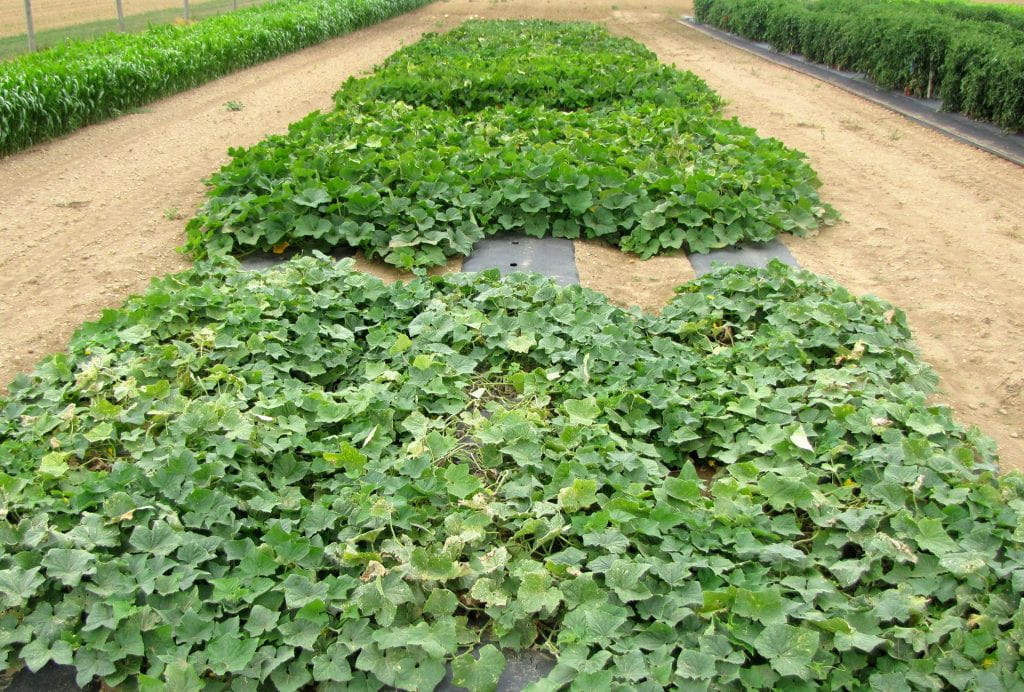
Procedures: To ensure leaf tissue for infection is present throughout the growing season in the sentinel plots, seedlings are transplanted into plots at two times, in June and July. Each cucurbit crop type in each planting is grown in a plot with 3 rows of at least 5 plants at 24-inch spacing. Seedlings are transplanted into beds with fertilizer and drip tape covered with black plastic mulch. Insecticides and fungicides with targeted activity for powdery mildew are applied. Leaves are examined routinely for symptoms. Plants are also checked for CDM in other research plantings and in commercial crops by the CCE IPM scouts.
Results: date of first symptoms and cucurbit crop type affected has varied a lot over the years on LI.
Table with date symptoms first seen on cucurbit species and crop type on Long Island since 2006. Most first observations were in sentinel plots at LIHREC which have been planted every year since 2008. Where there is no date, CDM was not seen on that cucurbit crop type that year.
| Cucumis sativus | Cucumis melo | Citrullus lanatus | Cucurbita moschata | Cucurbita pepo | Cucurbita maxima | |
| Year | Cucumber | Cantaloupe | Watermelon | Butternut squash | Acorn squash | Giant pumpkin z |
| 2006 | 15 Sep y | |||||
| 2007 | 14 Aug y | 15 Sep y | ||||
| 2008 | 27 Aug | 20 Sep | 9 Sep | 9 Sep | ||
| 2009 | 27 July | 6 Aug | 31 Aug | 31 Aug | ||
| 2010 | 7 Sep x | 7 Sep | 7 Sep | |||
| 2011 | 1 Aug | 17 Aug | 16 Sep | |||
| 2012 | 16 July | 13 Aug | 31 Aug | 22 Aug w | 23 Aug | |
| 2013 | 22 July | 6 Aug | 10 Sep | 16 Aug | 10 Sep | 19 Aug |
| 2014 | 2 Sep | |||||
| 2015 | 10 Aug | 24 Aug | 30 Aug | 18 Aug | 30 Aug | 30 Aug |
| 2016 | 8 Aug | 17 Aug | ||||
| 2017 | 31 July | 9 Aug | ||||
| 2018 | 14 Aug | 24 Aug w | ||||
| 2019 | 19 Aug w | 27 Aug | 27 Aug w | 16 Aug w | ||
| 2020 | 5 Aug w | 20 Aug | ||||
| 2021 | 14 July w | 4 Aug | 14 Sep | |||
| 2022 | 20 July w | 2 Aug | 1 Sep | 14 Sep |
z Switched to kabocha squash in 2020.
y CDM observations in research plots; there were no sentinel plots in 2006 and 2007.
x There was a widespread freeze in Florida the previous winter that likely affected pathogen survival.
w CDM observation in a commercial or research planting before the sentinel plots. Commercial plantings of C. pepo were Halloween pumpkin. In 2022 a grower reported seeing symptoms around 6 July.
Yearly details:
2008. Seedlings were transplanted on 10 June and 18 July. Symptoms were first observed on 27 August on cucumber in the sentinel plot and also in a commercial planting. Rain occurred on 11 and 15 August when the forecasted risk for downy mildew on Long Island was moderate and low, respectively, at the forecast website. Symptoms were found on 9 Sep on butternut squash and giant pumpkin, and on 20 September on cantaloupe.
2009. Seedlings were transplanted on 8 June and 9 July. Symptoms were first observed on 27 July on cucumber and on cantaloupe on 6 August and on butternut squash and giant pumpkin on 31 August. Symptoms were not found on acorn squash in the sentinel plot but did develop on this crop type in a nearby larger research planting. Watermelon also remained asymptomatic in the sentinel plot. Downy mildew was severe in 2009 in commercial plantings of cucumber, Halloween pumpkin, zucchini, acorn squash and butternut squash on Long Island where a recommended fungicide program had not been implemented. Most crops however had few or no symptoms of downy mildew.
2011. Seedlings were transplanted in early June and July. Symptoms of CDM were first observed on cucumber on 1 August, on cantaloupe on 17 August and on butternut squash on 16 September. None were seen on other crop types.
2012. Seedlings were transplanted on 1 June and 12 July. Symptoms of CDM were first observed on cucumber on 16 July. The pathogen likely was dispersed to Long Island on 3-4 July when there was a low to moderate risk predicted for the area by the Cucurbit Downy Mildew ipmPIPE forecasting system. Symptoms were observed on cantaloupe on 13 August, on giant pumpkin on 23 August, and on butternut squash on 31 August. None were found on watermelon or on acorn squash in the sentinel plots. However, CDM was seen on a commercial crop of Halloween pumpkin (Cucurbita pepo) in Brookhaven on 22 August.
2013. Seedlings were transplanted on 5 June and 10 July. Symptoms of CDM were first observed on cucumber on 22 July. Symptoms were observed on cantaloupe on 6 August, on butternut squash on 16 August, on giant pumpkin on 19 August, and on watermelon and acorn squash on 10 September.
2014. Seedlings were transplanted on 12 June and 10 July. Symptoms of CDM were not found until 2 September, which was substantially later than most previous years. This reflects reduced occurrence in much of the eastern U.S. in 2014. CDM was only observed in the second planting of cucumber. Ability to detect CDM was at least partly compromised by the fact plants were senescing and powdery mildew had become severe on many leaves by early September.
2015. Seedlings were transplanted on 5 June and 9 July. CDM was first found in cucumber on 10 August. Rain occurred 6 days earlier when there was a low risk predicted for the downy mildew pathogen to be successfully dispersed to eastern Long Island by the CDM forecasting program. Prior to this there were 3 days with forecasted risk: 8 July, 9 July, and 30 July. Symptoms were found on butternut squash on 18 August, on cantaloupe on 24 August, and on watermelon, acorn squash and giant pumpkin on 30 August.
2016. Seedlings were transplanted on 8 June and 12 July. A cucumber variety with moderate resistance to CDM (Marketmore) as well as a susceptible variety (Straight Eight) were grown. Symptoms of CDM were first observed on 8 August. Only the susceptible cucumber variety had symptoms. Only a few very new appearing lesions were observed on a total of 4 leaves in the 2 plantings. There was low risk forecast on 1 August by the CDM forecasting program, which is when the pathogen most likely was dispersed successfully to LI. One week is typical latent period from infection to visible symptoms. Prior to this forecast, there was one moderate risk forecast on 1 July and seven low risk forecasts on 4, 13, 14, 16, 18, 22 and 25 July; no risk forecast on other dates. On 15 August there were substantially more symptoms in Straight Eight in both plantings and symptoms were observed on the resistant variety. Symptoms of CDM were found in cantaloupe on 17 August. Only one plant in the second planting appeared to be affected. Symptoms looked fairly new. Overall severity was estimated to be <1%. There was high risk forecast on 10 August (when 0.07 inch rain fell at this location) and on 11 August (no rainfall). None of the other cucurbit crop types developed symptoms and there were no reports of downy mildew on these crops in other plantings on Long Island in 2016, therefore, only Clade 2 was present on Long Island in 2016.
2017. Seedlings were transplanted on 12 June and 10 July. CDM was first found in cucumber on 31 July and in cantaloupe on 9 August. On 24 July there was predicted high risk at the CDM forecasting program website for the pathogen to be successfully dispersed to Long Island from affected cucumber crops in upstate NY when conditions would be favorable for infection. One week is typical latent period between infection and symptom appearance. Thus this is likely when the pathogen was successfully dispersed to LI. There were a few days earlier starting on 1 July when high risk was also predicted but did not result in successful dispersal. None of the other cucurbit crop types developed symptoms and there were no reports of downy mildew on these crops in other plantings on Long Island in 2017, therefore, only Clade 2 was present on Long Island in 2017.
2018. Seedlings were transplanted on 1 June and 9 July. CDM was first found on 14 August, which was six days after the first high risk forecast for LI, thus that is probably when infection occurred. There was a moderate risk forecast for 17 July, 26 July, 1 August, 2 August, and 7 August. Symptoms were found in cucumber, which is the cucurbit type usually affected first at this location. None of the other cucurbit crop types developed symptoms; however, on 24 August symptoms were found in a commercial Halloween pumpkin planting.
2019. Seedlings were transplanted on 5 June and 10 July. In contrast with previous years, most first observations of CDM on a cucurbit crop type in Suffolk County was not in the sentinel plots. CDM was first found on 16 August in a Halloween pumpkin crop. On 7 August risk was forecast to be high for the pathogen being successfully transported to Long Island. Risk was also high on 13 August and may be when other pathogen types arrived. Symptoms were found on 19 August in a research planting of cucumber, which is the cucurbit type usually affected first, and on 27 August in cantaloupe in the sentinel plot and on butternut squash in a research planting. On 3 Sep CDM was found on cucumber and butternut squash in the sentinel plot. Symptoms were not found in watermelon, acorn squash, or kabocha squash.
2020. Seedlings were transplanted on 2 June and 21 July. CDM was observed on cucumber on 5 August in a commercial crop and on 17 August in the sentinel plot, and on cantaloupe on 20 August in the sentinel plot. Symptoms were not found in other cucurbit crop types. First seasonal predictions of risk for pathogen being dispersed to Long Island was a moderate risk on 6, 7 and 8 July and low risk on 10, 11, and 12 July. There was also a moderate risk on 17 and 23 July and low risk on 22, 24, 28 and 30 July. The first high risk forecast in 2020 was 4 August associated with Hurricane Isaias; the next was 7 August.
2021. Seedlings were transplanted on 3 June and 20 July. CDM was observed on cucumber on 14 and 20 July in commercial crops on the North Fork and the South Fork of Long Island, respectively, and on 26 July in the sentinel plot. On 14 July, few symptoms were found in the planting except for a hot spot with leaves severely affected; no symptoms were found the previous week. Symptoms looked very new and there was limited sporulation further supporting that it was a new infection. 8 July was the first high-risk forecast for this region in 2021 and likely when spread occurred to the first crop where downy mildew was found. There were also high-risk forecasts on 9, 11, 17, and 18 July that could account for spread to the other locations. 14 July is the earliest that downy mildew has been found on Long Island, but it was expected because the disease was found earlier than usual in 2021 in New Jersey (16 June), which is a likely source of spores for Long Island. Since 2007, first occurrence on Long Island has averaged 32 days after first occurrence in New Jersey. Symptoms were found in the sentinel plot on cantaloupe on 4 August and on butternut squash on 14 September. Symptoms were not found in the three other cucurbit crop types in the sentinel plots.
2022. Seedlings were transplanted on 28 June. CDM was first observed on Long Island on cucumber on 20 July in a commercial crop on the North Fork (Cutchogue) that was being scouted weekly through the Cornell Cooperative Extension IPM Program. CDM first appeared on LI around 6 July when a grower in central Suffolk (Brentwood) first saw symptoms on cucumber; CDM was severe in images submitted for diagnosis on 27 July. This is the earliest that downy mildew has been found on LI; 14 July in 2021 was the previous earliest date. CDM was first observed in the sentinel plots on both cucumber and cantaloupe on 2 August. There were very few very new symptoms then. On 11 Aug, CDM was first observed on the South Fork (East Hampton) in cucumber and cantaloupe crops being scouted weekly. The first high risk forecast at the CDM forecasting program website for the pathogen to be successfully dispersed to Long Island from affected cucumber crops in New Jersey and eastern Pennsylvania was 27 June; infection then would result in visible symptoms around 6 July. The next high risk forecast was 2 July followed by moderate risk forecasts on 5, 12, and 14 July. The crop observed to have CDM on 20 July likely was first infected on 2 or 5 July based on the fact a few old appearing spots were found plus several new spots indicating spread occurred in the crop. The next high risk forecasts were 25 and 28 July, which correspond with symptoms observed on 2 Aug in the sentinel plots. Symptoms found on watermelon on 1 September looked like they may have first appeared at least a week earlier; however, since 17 August the only high risk forecast was on 22 August when it rained. The likely source of spores dispersed to the plot on that day was an unreported occurrence because there were no reports of downy mildew on watermelon logged at the Cucurbit Downy Mildew Forecast webpage near enough to Long Island to be an expected source of spores: nearest reported case was in South Carolina.
Images
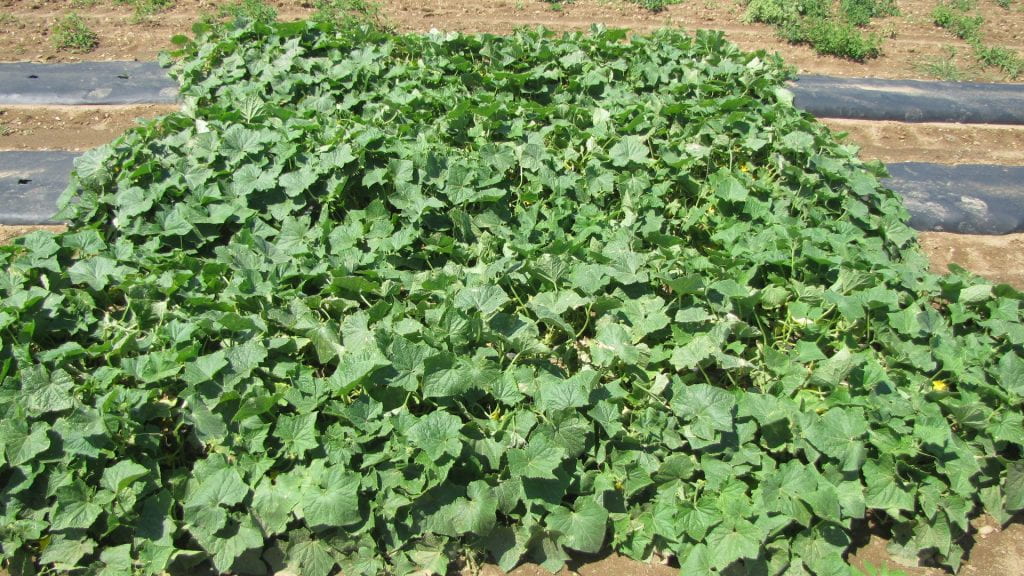
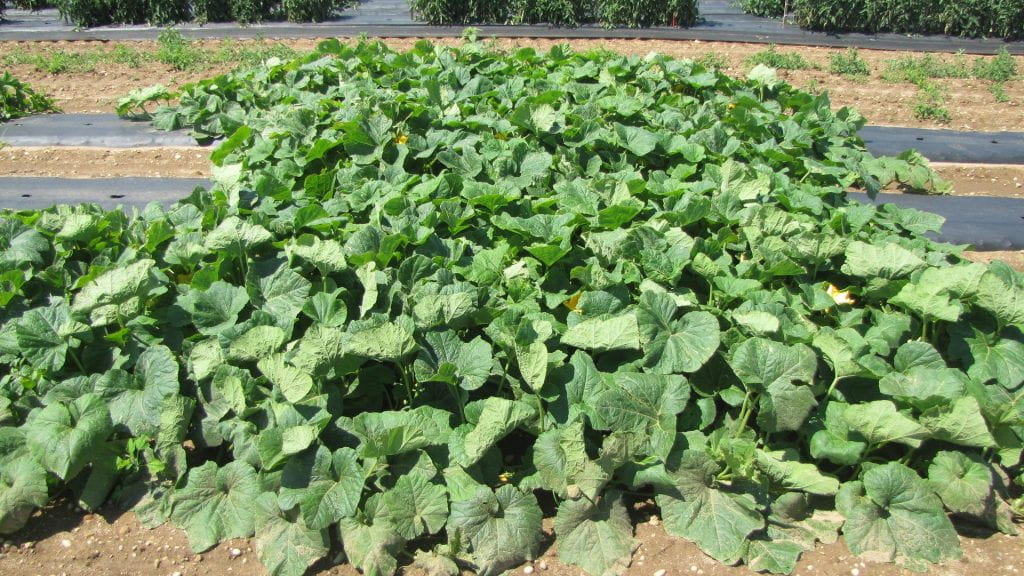
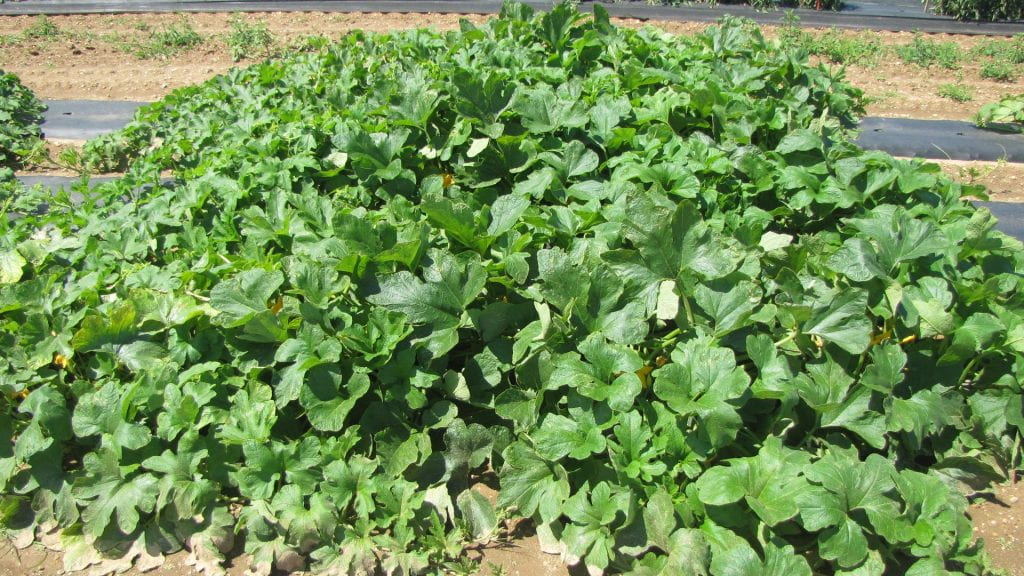
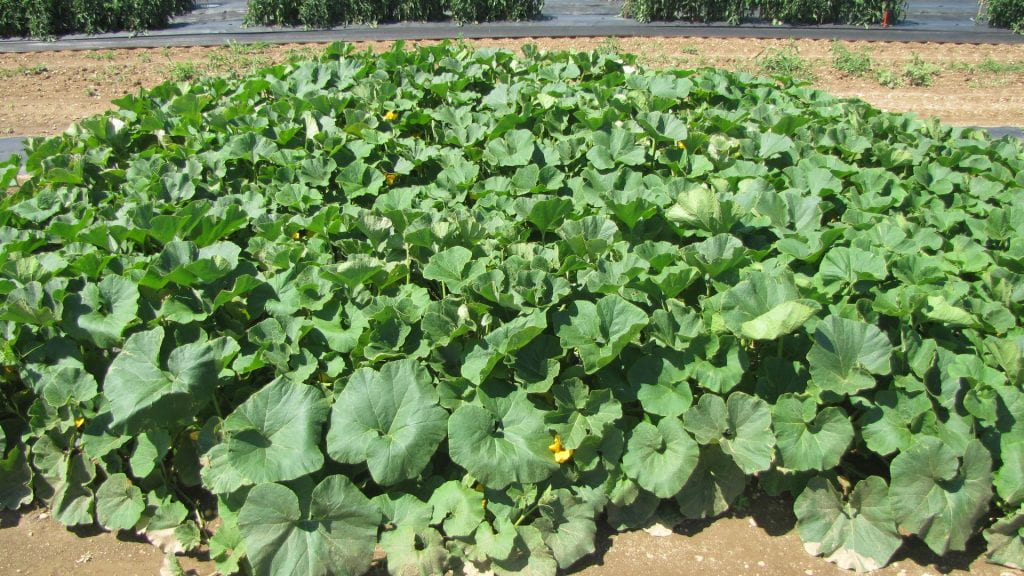
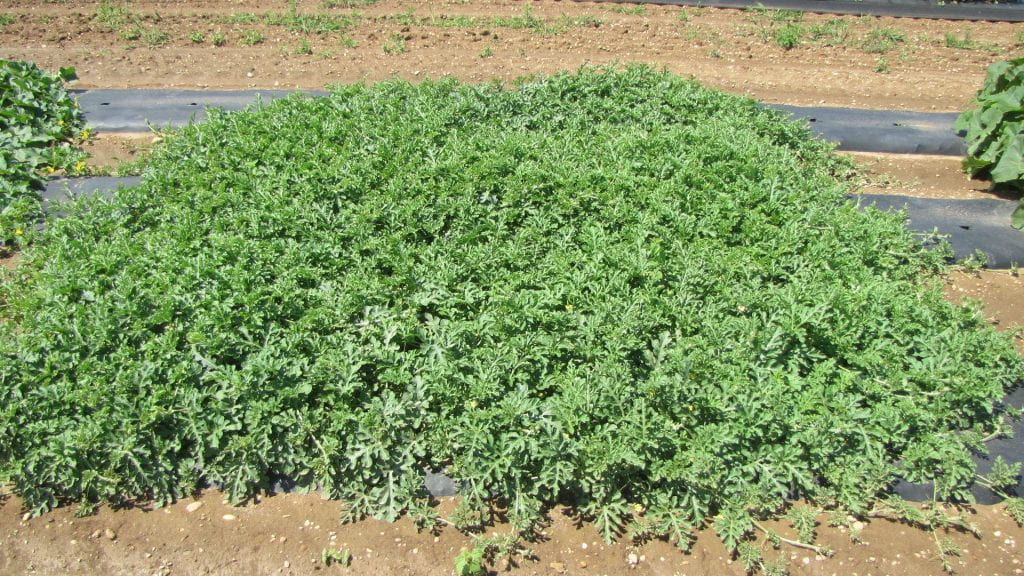
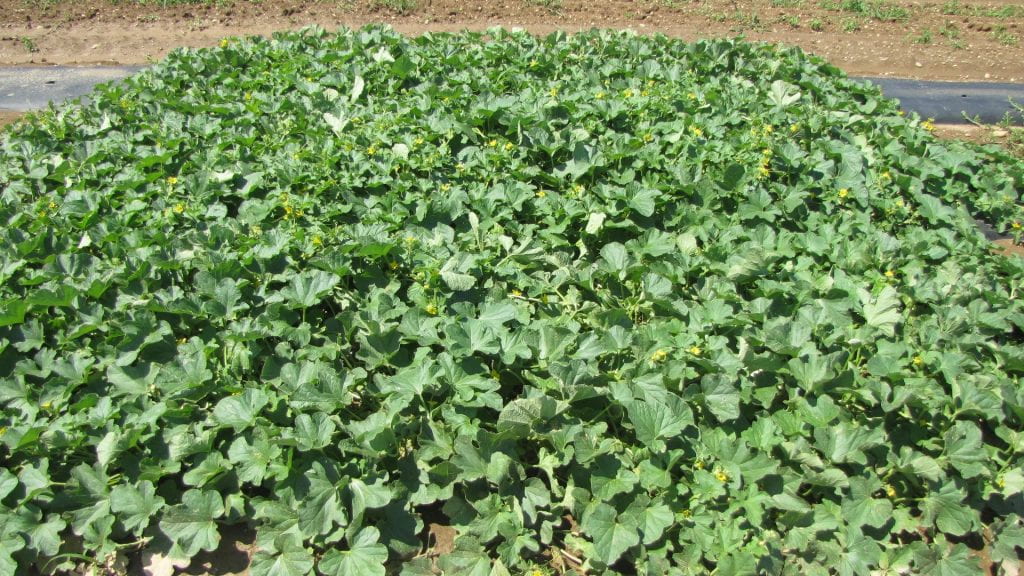
Fungicide Evaluations – Conventional Products
Publications about conventional fungicide evaluations (click on publication year to download report; experiments were conducted the previous year; all are also available at Plant Disease Management Reports website):
- McGrath, M. T., and Davey, J. F. 2007. Evaluation of fungicides for managing downy mildew of winter squash, 2006. Plant Disease Management Reports 1:V146.
- McGrath, M. T., and Davey, J. F. 2007. Evaluation of fungicides for the management of powdery and downy mildews of winter squash, 2006. Plant Disease Management Reports 1:V148.
- McGrath, M. T., and Fox, G. M. 2008. Assessment of field resistance to pyraclostrobin- and mefenoxam-based fungicides for managing downy mildew in cucumber, 2007. Plant Disease Management Reports 2:V149.
- McGrath, M. T., and Fox, G. M. 2008. Evaluation of fungicides for managing downy mildew in winter squash, 2007. Plant Disease Management Reports 2:V150.
- McGrath, M. T., and Hunsberger, L. K. 2012. Efficacy of fungicides for managing downy mildew in cucumber, 2011. Plant Disease Management Reports 6:V008.
- McGrath, M. T. and LaMarsh, K. A. 2013. Efficacy of fungicides for managing downy mildew in cucumber, 2012. Plant Disease Management Reports 7:V019.
- McGrath, M. T. and LaMarsh, K. A. 2014. Efficacy of fungicides for managing downy mildew in cucumber, 2013. Plant Disease Management Reports 8:V192.
- McGrath, M. T. and Sexton, Z. F. 2017. Efficacy of fungicides for managing downy mildew organically in cucumber, 2016. Plant Disease Management Reports 11:V023.
- McGrath, M. T. and Sexton, Z. F. 2019. Efficacy of conventional and organic fungicides for managing downy mildew in cucumber, 2018. Plant Disease Management Reports 13:V118.
- McGrath, M. T. and Sexton, Z. F. 2020. Efficacy of fungicides for managing downy mildew in cucumber, 2019. Plant Disease Management Reports 14:V074.
Fungicide Resistance – In-Field Seedling Bioassays
The bioassay entails treating potted plants at the 2- to 4-leaf stage with different fungicide doses, exposing them to the downy mildew pathogen by putting them next to infected field-grown plants for two days, then keeping them in a greenhouse until downy mildew develops and severity is rated. Efficacy of each treatment is assessed by comparing severity to that on non-treated control plants. Cucumber is used because this is the cucurbit crop type most commonly affected by downy mildew. The procedure was first used for cucurbit powdery mildew; details about the procedure are at that page. Important procedural differences include:
1. using a variety susceptible to downy mildew and resistant to powdery mildew such as Silver Slicer,
2. routinely checking seedlings for symptoms of powdery mildew and treating with a targeted fungicide if seen,
3. using a two-day exposure period ideally when overnight there will be dew or very high humidity so that infection can occur,
4. conducting the first assessment when downy mildew symptoms first appear, which often has been 6 days after putting the seedlings out, because severely infected leaves die quickly, and
5. enclosing seedlings in garbage bags overnight after symptoms have developed to confirm they are due to downy mildew if the greenhouse is not sufficiently humid for sporulation to occur.
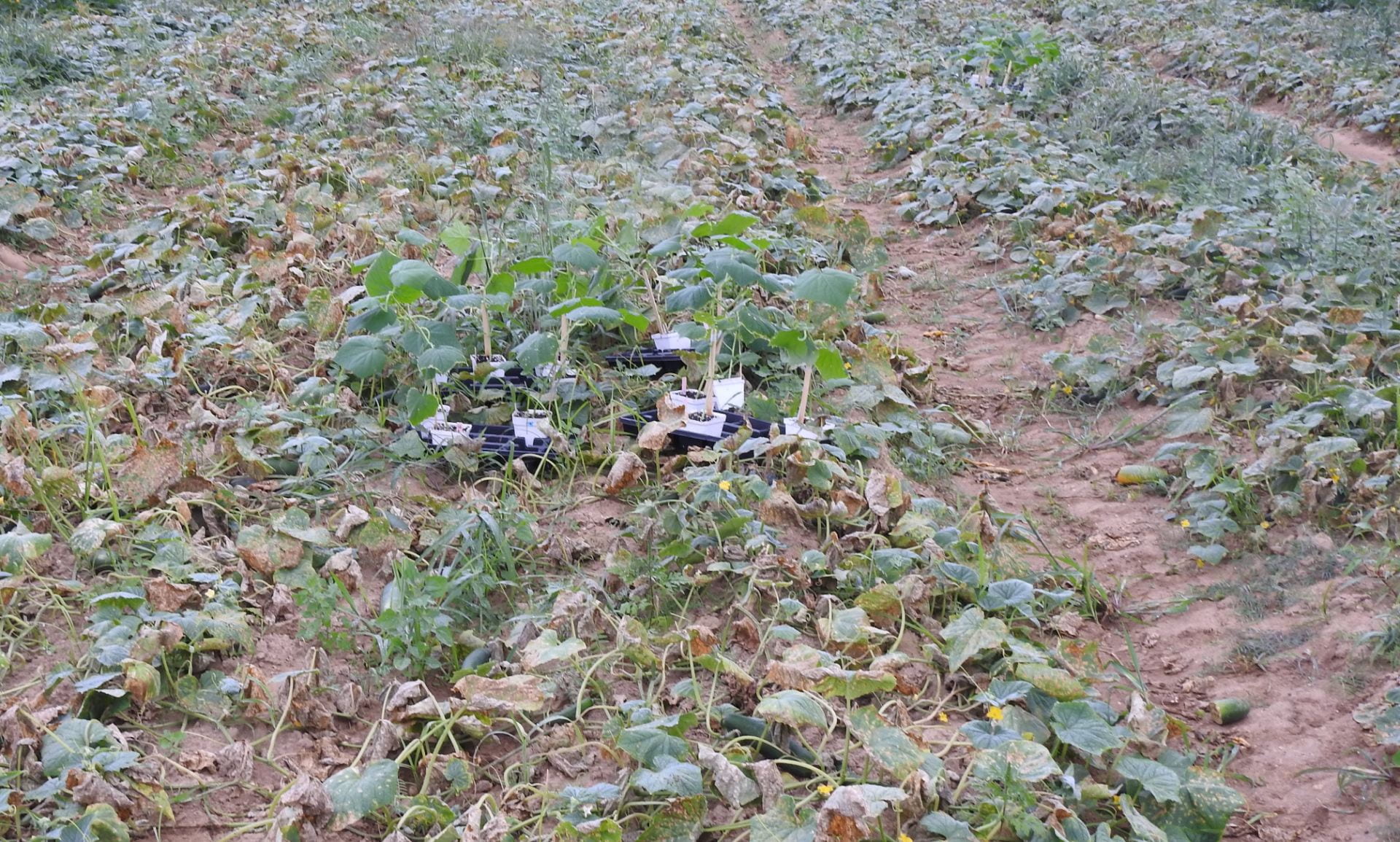
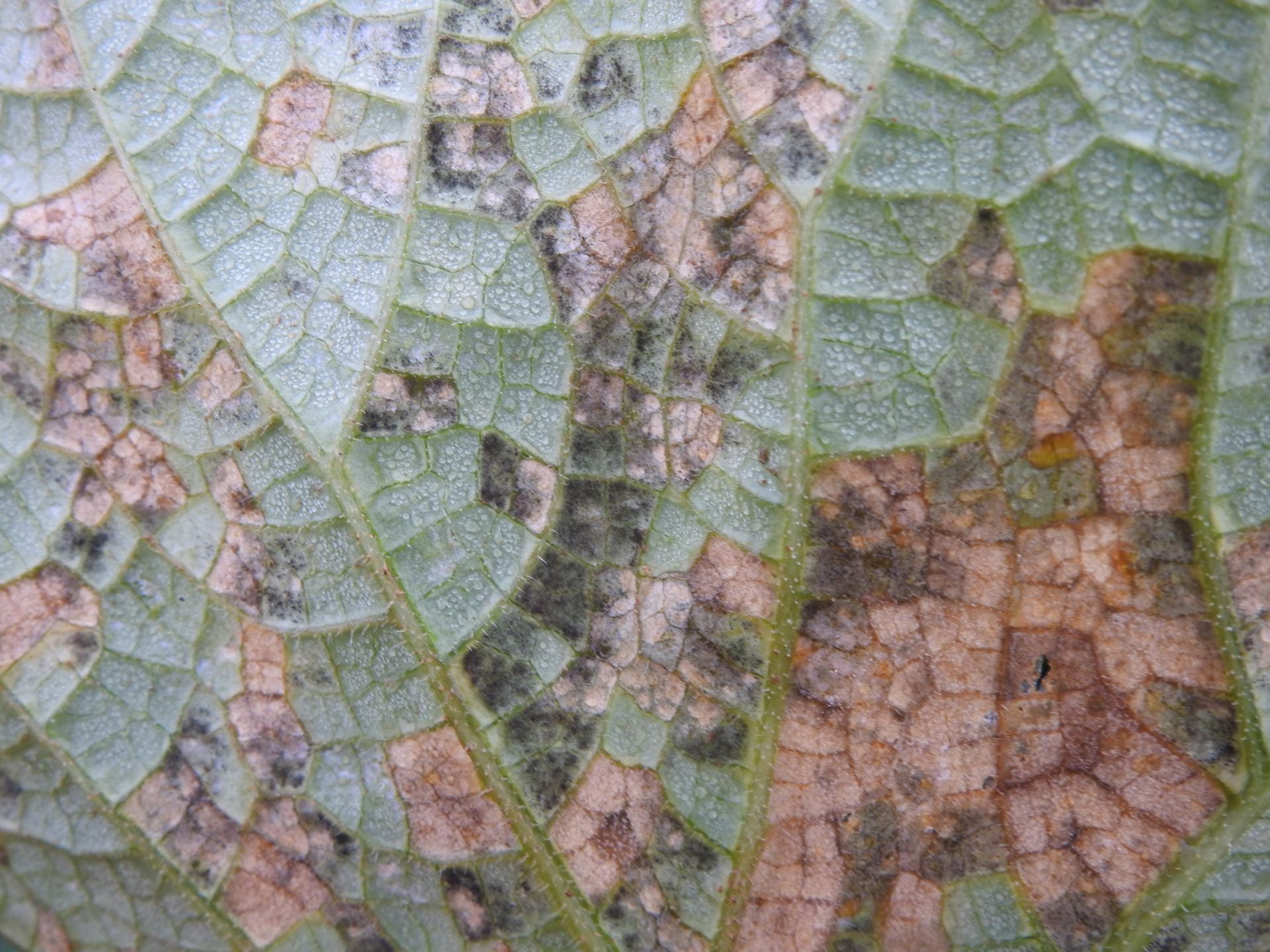
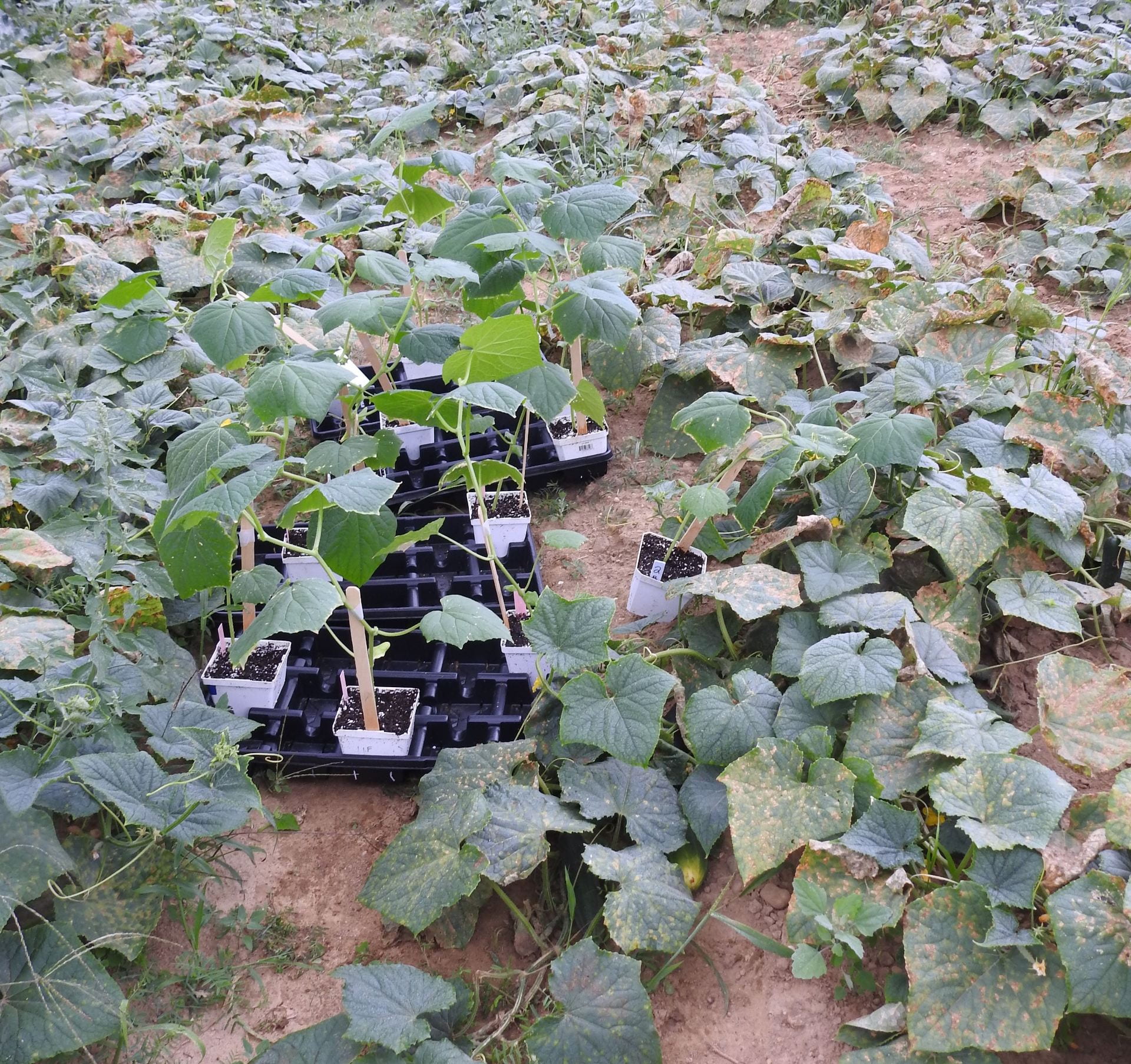
Efficacy for cucurbit downy mildew of fungicides at risk for resistance development based on results from seedling bioassays conducted on Long Island, NY.
| FRAC Code | Fungicide | 2021 | 2019 | 2018 | 2017 | 2016 |
| 4 | Ridomil z | not tested | not tested | not tested | not tested | not tested |
| 11 | Quadris | ineffective | ineffective | ineffective | ineffective | Mod. effective |
| 40 | Revus | ineffective | ineffective | ineffective | ineffective | Mod. effective |
| 40 | Forum | Mod. effective | Mod. effective | EFFECTIVE | ineffective | ineffective |
| 43 | Presidio | ineffective | Mod. effective | ineffective | EFFECTIVE | EFFECTIVE |
| 22 | Elumin v | Mod. effective | not tested | not tested | not tested | not tested |
| 27 | Curzate, Tanos y | EFFECTIVE | EFFECTIVE | EFFECTIVE | Mod. effective | EFFECTIVE |
| 28 | Previcur Flex | EFFECTIVE | EFFECTIVE | EFFECTIVE | Mod. effective | EFFECTIVE |
| 22 | Zing!, Gavel, or Zoxamide x | EFFECTIVE | Mod. effective | EFFECTIVE | EFFECTIVE | EFFECTIVE |
| 21 | Ranman | EFFECTIVE | EFFECTIVE | EFFECTIVE | EFFECTIVE | EFFECTIVE |
| 45 | Zampro w | not tested | not tested | EFFECTIVE | EFFECTIVE | EFFECTIVE |
| 29 | Omega | EFFECTIVE | EFFECTIVE | not tested | not tested | not tested |
| 49 | Orondis | EFFECTIVE | EFFECTIVE | EFFECTIVE | not tested | not tested |
z Not tested because resistance considered to be widespread in the USA.
y Curzate was tested. Tanos has the same active ingredient (cymoxanil).
x Zing! was used in 2017 and 2016. The active ingredient in both products (zoxamide) was used in 2018 and 2019 because these products also contain a protectant fungicide.
w Zampro is not permitted used on Long Island.
v Elumin is not registered for use in NY (2023).
Publications about bioassay results (click on publication year to download report):
- McGrath, M. T. and Sexton, Z. F. 2018. Fungicide sensitivity of cucurbit downy mildew pathogen population on Long Island, NY, determined with seedling bioassay, 2017. Plant Disease Management Reports 12:V152.
- McGrath, M. T. and Sexton, Z. F. 2019. Fungicide sensitivity of cucurbit downy mildew pathogen population on Long Island, NY, determined using a seedling bioassay, 2018. Plant Disease Management Reports 13:V084.
- McGrath, M. T. and Sexton, Z. F. 2020. Fungicide sensitivity of cucurbit downy mildew pathogen population on Long Island, NY, determined using a seedling bioassay, 2019. Plant Disease Management Reports 14:V073.
- Jones, J., Everts, K. L., McGrath, M. T., and Gugino, B. K. 2021. Efficacy of fungicides for Pseudoperonospora cubensis determined using bioassays over multiple years in the Mid-Atlantic and Northeastern United States. Plant Health Progress. doi.org/10.1094/PHP-10-20-0086-FI
- McGrath, M. T. and Downing C. T. 2022. Fungicide sensitivity of cucurbit downy mildew pathogen population on Long Island, NY, determined using a seedling bioassay, 2021. Plant Disease Management Reports 16:V103.
Plant Resistance Evaluations – New and Experimental Varieties
Evaluations are listed by year conducted followed by the downy mildew resistant (DMR) varieties tested and the susceptible variety they were compared to. The linked webpages have photographs. Publication list has links to downloadable published reports with methods, results, and data table for recent evaluations.
Cucumber
2021: Brickyard (new variety), TSX-CU231AS (experimental variety from Tokita), Bristol, and DMR401 were compared to Speedway. All are slicer types. Symptoms were first seen on the susceptible variety just 11 days after transplanting. All DMR varieties provided effective suppression: DMR401 (94% control), TSX-CU231AS (87%), Brickyard (76%), and Bristol (57%). For more information see: Evaluation of Cucumber Varieties Resistant to Downy Mildew, 2021
2017: Bristol, Diamondback, DMR 401, Marketmore 76, Speedway, SV4719CS, and SV3462CS (all slicer types) plus Citadel (fresh-market pickle type) were compared to Straight Eight. Good DM suppression was exhibited by DMR 401 (75% control), Bristol (50%), and Citadel (49%). DM started developing just 2 wks after transplanting and severely impacted yield and fruit quality. DMR 401 produced substantially more marketable fruit than the others. For more information see: Evaluation of Cucumber Varieties Resistant to Downy Mildew, 2017
Melon
2022: Excellent control was achieved with a conventional fungicide program applied starting after symptoms found (IPM schedule) to the resistant varieties Trifecta, Edisto 47, and Planter’s Jumbo. Resistance provided moderate suppression (29%) based on comparison of untreated Trifecta and untreated susceptible variety (Ambrosia). Trifecta fruit had highest sugar content (Brix) and received highest average ratings for taste, texture, and internal appearance. For more information see: Evaluation of Downy Mildew Resistant Cantaloupe Varieties in an Integrated Program with Fungicides Applied on an IPM Schedule, 2022
2021: The resistant varieties Trifecta and Edisto 47 exhibited good suppression of downy mildew compared to Hales Best and Sugar Rush. For more information see: Evaluation of Cantaloupe Varieties Resistant to Downy Mildew, 2021
Publications about resistant variety evaluations (click on publication year to download report):
- McGrath, M. T., and Fox, G. M. 2009. Susceptibility to downy mildew of pickling-type cucumber cultivars, 2008. Plant Disease Management Reports 3:V114.
- McGrath, M. T., and Fox, G. M. 2009. Susceptibility to downy mildew of slicer-type cucumber cultivars, 2008. Plant Disease Management Reports 3:V115.
- McGrath, M. T., and Fox, G. M. 2010. Susceptibility to downy mildew of pickling-type cucumber cultivars, 2009. Plant Disease Management Reports 4:V117.
- McGrath, M. T., and Fox, G. M. 2010. Susceptibility to downy mildew of slicer-type cucumber cultivars, 2009. Plant Disease Management Reports 4:V121.
- McGrath, M. T., Menasha, S. R., and LaMarsh, K. A. 2013. Evaluation of downy mildew resistance in experimental hybrids of cucumber, 2012. Plant Disease Management Reports 7:V018.
- McGrath, M. T. and LaMarsh, K. A. 2015. Evaluation of downy mildew resistance in experimental hybrids of cucumber, 2014. Plant Disease Management Reports 9:V024.
- McGrath, M. T., Menasha, S. R., and Sexton, Z. F. 2018. Evaluation of cucumber cultivars resistant to downy mildew, 2017. Plant Disease Management Reports 12:V069.
- McGrath, M. T. and Downing, C. T. 2022. Evaluation of downy mildew resistant cultivars of cantaloupe, 2021. Plant Disease Management Reports 16:V104.
- McGrath, M. T. and Downing, C. T. 2022. Evaluation of downy mildew resistant cultivars of cucumber, 2021. Plant Disease Management Reports 16:V102.
- McGrath, M. T. and Downing, C. T. 2023. Evaluation of a fungicide program applied on an IPM schedule to downy mildew susceptible and resistant cultivars of cantaloupe, 2022. Plant Disease Management Reports 17:V060.
More information/prepared by:
Margaret Tuttle McGrath
Associate Professor
Long Island Horticultural Research and Extension Center (LIHREC)
Plant Pathology and Plant-Microbe Biology Section
School of Integrative Plant Science
College of Agriculture and Life Sciences
Cornell University
mtm3@cornell.edu


